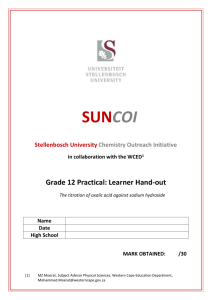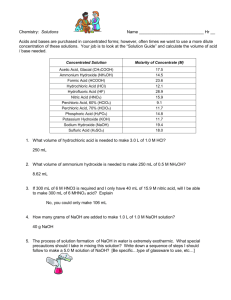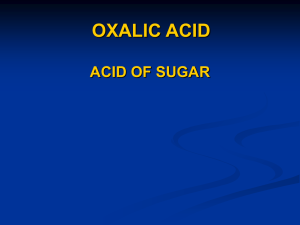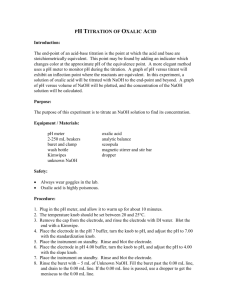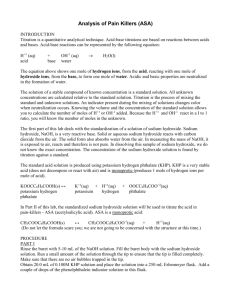Titration
advertisement
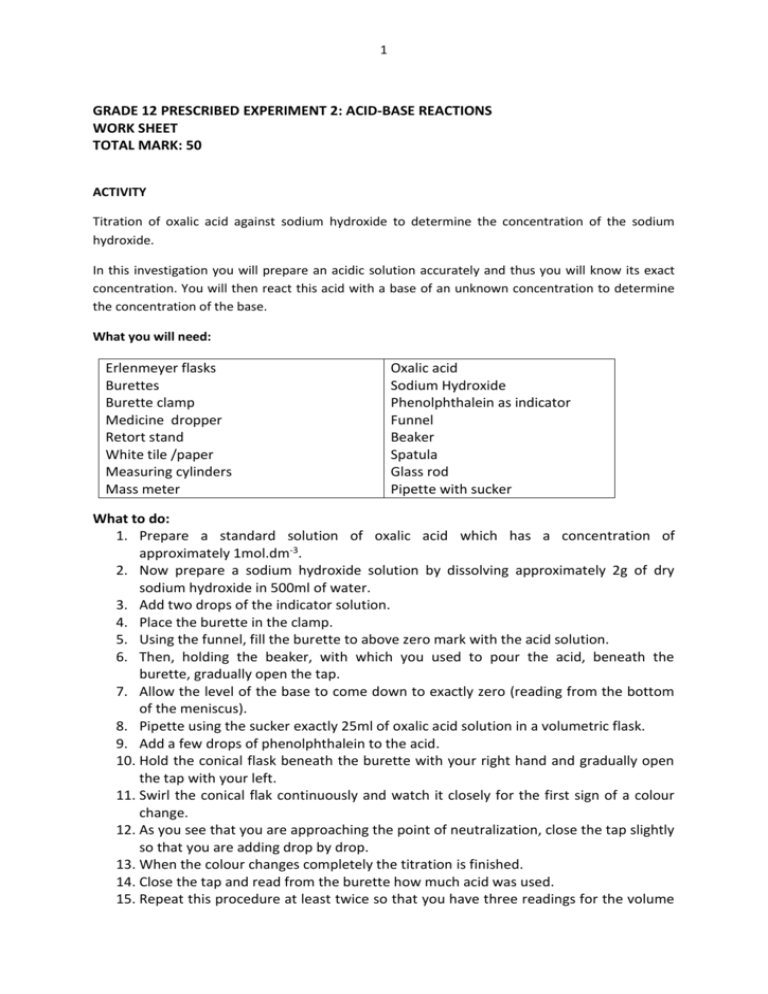
1 GRADE 12 PRESCRIBED EXPERIMENT 2: ACID-BASE REACTIONS WORK SHEET TOTAL MARK: 50 ACTIVITY Titration of oxalic acid against sodium hydroxide to determine the concentration of the sodium hydroxide. In this investigation you will prepare an acidic solution accurately and thus you will know its exact concentration. You will then react this acid with a base of an unknown concentration to determine the concentration of the base. What you will need: Erlenmeyer flasks Burettes Burette clamp Medicine dropper Retort stand White tile /paper Measuring cylinders Mass meter Oxalic acid Sodium Hydroxide Phenolphthalein as indicator Funnel Beaker Spatula Glass rod Pipette with sucker What to do: 1. Prepare a standard solution of oxalic acid which has a concentration of approximately 1mol.dm-3. 2. Now prepare a sodium hydroxide solution by dissolving approximately 2g of dry sodium hydroxide in 500ml of water. 3. Add two drops of the indicator solution. 4. Place the burette in the clamp. 5. Using the funnel, fill the burette to above zero mark with the acid solution. 6. Then, holding the beaker, with which you used to pour the acid, beneath the burette, gradually open the tap. 7. Allow the level of the base to come down to exactly zero (reading from the bottom of the meniscus). 8. Pipette using the sucker exactly 25ml of oxalic acid solution in a volumetric flask. 9. Add a few drops of phenolphthalein to the acid. 10. Hold the conical flask beneath the burette with your right hand and gradually open the tap with your left. 11. Swirl the conical flak continuously and watch it closely for the first sign of a colour change. 12. As you see that you are approaching the point of neutralization, close the tap slightly so that you are adding drop by drop. 13. When the colour changes completely the titration is finished. 14. Close the tap and read from the burette how much acid was used. 15. Repeat this procedure at least twice so that you have three readings for the volume 2 of NaOH (of unknown concentration) required to neutralize exactly 25ml of oxalic acid (of known concentration). 16. Take an average of these three and use it to calculate the concentration of the NaOH. 17. Now calculate the concentration of the sodium hydroxide solution. 18. Make a neat labeled sketch to represent the apparatus 19. Now write a report using the format learnt in class. Questions 1. What is the appropriate concentration of NAOH (2g in 500ml of water) 2. Calculate the theoretical concentration of NaOH from the actual mass of NaOH you measured. 3. How does your theoretical value for NaOH concentration (from the actual mass you measured) differ from the actual concentration you calculated (from the titration procedure)? Can you think of some reasons why your values may differ? 3 MEMORANDUM 1. Title ACID- BASE TITRATION 2. AIM To determine the concentration of Sodium Hydroxide (NaOH) using a standard solution of Oxalic acid (H2C204) 3. MATERIALS (APPARATUS & CHEMICALS) Apparatus: Chemical 1. Erlenmeyer flasks 1. Oxalic acid 2. Burettes 2. Sodium Hydroxide 3. Medicine dropper 3. Phenopthalein as indicator 4. Retort stand 5. White tile /paper 6. Measuring cylinders 4. PRECAUTIONARY MEASURES Safety glasses must be worn The use of gloves is recommended Test run before doing actual titration experiment Contamination from dirty glassware Oxalic acid solution becoming lumpy / forming precipitate ‘Overshooting’ the mark Volumetric flask calibrated at a specific temperature (e.g. room temperature) 5. SAFETY AUDIT ON: 1. Oxalic acid 2. Sodium Hydroxide (4) 6. DATA COLLECTION Experiment 1, 2 & 3 Concentration of oxalic acid: 1mol/dm3 Concentration of base (sodium hydroxide): unknown Experiment Number. Volume of Acid(mℓ) Volume of NaOH(mℓ) 1 25 mℓ 2 25 mℓ 3 25 mℓ The average of the results obtained: _____________ ml of NaOH solution. (2) What is your observation/colour change at the end point? ________________________________________________________________________ (2) 7. CONCLUSION__________________________________________________________ _____________________________________________________________________ __________________________________________________________________ (1) 4 8. CALCULATIONS (a) Write the balanced equation for the reaction _________________________________________________________________________(3) (b) Calculate the concentration of the unknown solution using the equation nbCaVa = naCbVb ___________________________________________________________________________ ___________________________________________________________________________ ___________________________________________________________________________ ___________________________________________________________________________ ___________________________________________________________________________ ___________________________________________________________________________ ___________________________________________________________________________ ___________________________________________________________________________ ___________________________________________________________________________ ___________________________________________________________________________ ___________________________________________________________________________ ___________________________________________________________________________ ___________________________________________________________________________ ___________________________________________________________________________ ________________________________________________________________________ (7) TOTAL [50] SAFETY AUDITS ON: Oxalic acid √√ FIRE Combustible. Gives off irritating or toxic fumes (or gases) in a fire. NO open flames. Powder, alcohol-resistant foam, water spray, carbon dioxide. In case of fire: keep drums, etc., cool by spraying with water. EXPLOSION EXPOSURE AVOID ALL CONTACT! IN ALL CASES CONSULT A DOCTOR! Inhalation Sore throat. Cough. Burning sensation. Shortness of breath. Laboured breathing. Symptoms may be delayed (see Notes). Local exhaust or breathing protection. Fresh air, rest. Half-upright position. Artificial respiration if indicated. Refer for medical attention. Skin Redness. Skin burns. Pain. Blisters. Protective clothing. First rinse with plenty of water, then remove contaminated clothes and rinse again. Refer for medical attention. Eyes Redness. Pain. Loss of vision. Severe deep burns. Face shield, or eye protection in combination with breathing protection if First rinse with plenty of water for several minutes (remove contact lenses if 5 FIRE Not combustible. Contact with moisture or water may generate sufficient heat to ignite combustible substances. In case of fire in the surroundings: use appropriate extinguishing media. EXPLOSION AVOID ALL CONTACT! EXPOSURE Inhalation Ingestion IN ALL CASES CONSULT A DOCTOR! Corrosive. Burning sensation. Local exhaust or breathing Fresh air, rest. Half-upright Sore throat. Cough. Laboured protection. position. Artificial respiration breathing. Shortness of may be needed. Refer for breath. Symptoms may be medical attention. delayed (see Notes). Sore throat. Burning sensation. Abdominal pain. Vomiting. Drowsiness. Shock or collapse. Convulsions. powder. easily possible), then take to a doctor. Do not eat, drink, or smoke during work. Wash hands before eating. Rinse mouth. Rest. Refer for medical attention. 6 Skin Corrosive. Redness. Pain. Protective gloves. Protective Remove contaminated Serious skin burns. Blisters. clothing. clothes. Rinse skin with plenty of water or shower. Refer for medical attention. Eyes Corrosive. Redness. Pain. Face shield or eye protection First rinse with plenty of Blurred vision. Severe deep in combination with breathing water for several minutes burns. protection if powder. (remove contact lenses if easily possible), then take to a doctor. Ingestion Corrosive. Burning sensation. Do not eat, drink, or smoke Rinse mouth. Do NOT induce Abdominal pain. Shock or during work. vomiting. Give plenty of water collapse. to drink. Refer for medical attention. SODIUM HYDROXIDE (NaOH) √√ APPROPRIATE SKETCH burette Retort stand Erlenmeyer flask White tile (6) Burette with oxalic acid Retort stand Erlenmeyer flask with NaOH White tile √√ √ √√ √ 6. DATA COLLECTION Experiment 1,2 & 3 Concentration of Oxalic acid: 1mol/dm3 Concentration of base (NaOH): unknown 7 No. 1 2 3 Volume of NaOH(mℓ) 50 mℓ 50 mℓ 50 mℓ Volume of Oxalic acid (ml) 43 mℓ √ 44 mℓ √ 41 mℓ √ The average of the results obtained: 42 mℓ √ Colour of phenopthalein changes from pink to colourless 7. CONCLUSION: 50ml NaOH solution of 0.42 mol.dm-3 neutralises 42ml oxalic acid solution of 1 mol.dm-3 (1) 8. CALCULATIONS a) Write the balanced equation for the reaction 2NaOH + H 2C 2O 4 √ → Na 2C 2O 4 √ + 2H 2O √ b) Calculate the concentration of the unknown solution using the equation n bC aV a = n aC bV b 1x1x 0.042 = 2 X Cb x 0.05 C b = 0.42 mol/dm3 (7) TOTAL [25] HOW SECTION 1.3 (CAPS) CAN FEATURE IN THE EXPERIMENT Refer to CAPS page 5 d, bullet 1-5 identify and solve problems and make decisions using critical and creative thinking; work effectively as individuals and with others as members of a team; organise and manage themselves and their activities responsibly and effectively; collect, analyse, organise and critically evaluate information; communicate effectively using visual, symbolic and/or language skills in various modes; Suggestions on how to improve: You can let them write an equation before they perform the experiment Don’t ask questions like ‘is it a weak or strong acid: because there is 50% chance of guessing Pour the oxalic acid in the burette & NaOH in the Erlenmeyer flask because cleaning the NaOH from burette is difficult & burette might break
